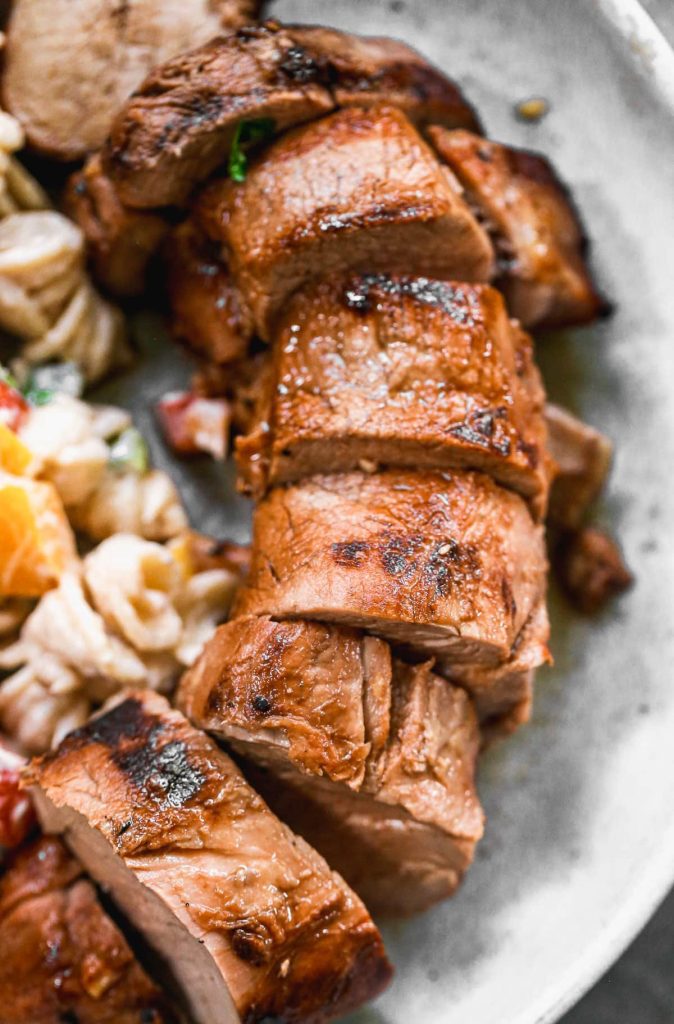Are you ready to impress your friends and family with a mouthwatering pork roast straight off your gas grill? Look no further! In this article, we’ll walk you through the step-by-step process of how to grill a pork roast on a gas grill. From selecting the perfect cut to achieving that deliciously juicy interior and perfectly charred exterior, we’ve got you covered. Get ready to elevate your grilling game and master the art of grilling a pork roast on a gas grill. Let’s dive in!
# How to Grill a Pork Roast on a Gas Grill
Grilling a pork roast on a gas grill can be a delicious and flavorful way to prepare this succulent cut of meat. Whether you’re hosting a backyard barbecue or simply craving a mouthwatering roast, this guide will take you step by step through the process of grilling a pork roast on a gas grill. From choosing the right cut of pork to achieving that perfect sear, you’ll learn all the tips and tricks to elevate your grilling game. Let’s dive in!
## Selecting the Perfect Cut of Pork
Before you embark on your grilling adventure, it’s important to choose the right cut of pork roast. Here are some popular options:
### 1. Pork Loin Roast
The pork loin roast is a lean and tender cut that grills to perfection. It’s typically boneless and offers a mild flavor, making it a versatile choice for various recipes.
### 2. Pork Shoulder Roast
Also known as pork butt or Boston butt, the pork shoulder roast is a flavorful and marbled cut that’s perfect for slow cooking and grilling. It’s a bit fattier compared to the pork loin roast, resulting in a rich and juicy final dish.
### 3. Pork Tenderloin
Although technically not a roast, the pork tenderloin is a fantastic option for grilling. It’s a lean and tender cut that cooks quickly and is ideal for smaller gatherings or when you’re short on time.
When selecting your pork roast, look for well-marbled meat with a vibrant pink color. Avoid any cuts with excessive fat or discoloration. Once you’ve chosen the perfect cut, it’s time to move on to the next step.
## Preparing the Pork Roast
Properly preparing the pork roast before grilling is essential to ensure a tasty and tender outcome. Follow these steps:
### 1. Trim Excess Fat
Trim any excess fat from the pork roast using a sharp knife. Leaving just a thin layer of fat will enhance flavor and prevent flare-ups during grilling.
### 2. Seasoning
Season the pork roast generously with your favorite dry rub or marinade. The flavors will penetrate the meat during grilling, adding depth and enhancing taste.
### 3. Resting Time
Allow the seasoned pork roast to rest at room temperature for about 30 minutes. This rest time helps the meat cook more evenly and retains its natural juices.
While the pork roast is resting, it’s a perfect opportunity to preheat and prepare the gas grill.
## Preheating and Setting Up the Gas Grill
Properly preheating and setting up your gas grill is crucial for achieving those beautiful sear marks and even cooking. Let’s go through the steps:
### 1. Clean the Grill Grates
Start by thoroughly cleaning the grill grates. Use a grill brush to remove any leftover residue from previous cooking sessions. Clean grates ensure optimal sear and prevent the pork roast from sticking.
### 2. Preheat the Grill
Turn on the gas grill and preheat it to medium-high heat, around 400°F (204°C). Preheating allows the grill grates to become hot, ensuring a consistent and even cooking temperature.
### 3. Set Up Direct and Indirect Heat Zones
Create a direct heat zone and an indirect heat zone on your gas grill. The direct heat zone is where you’ll sear the pork roast, while the indirect heat zone is where you’ll finish cooking it. This setup allows for a perfect combination of searing and gentle heat, resulting in a juicy and flavorful roast.
Position the burners on one side of the grill to create the direct heat zone. Leave the other side with no burners on for the indirect heat zone. If you have a three-burner grill, turn on the outer burners while keeping the middle burner off.
Now that your grill is preheated and set up correctly, it’s time to grill the pork roast.
## Grilling the Pork Roast
Grilling a pork roast requires precise heat control and timing. Follow these steps for a delicious outcome:
### 1. Searing the Pork Roast
Place the seasoned pork roast on the direct heat zone of the grill. Sear each side for about 3-4 minutes, or until you achieve a beautiful golden-brown crust. This initial sear locks in the juices and adds a delightful smoky flavor to the meat.
### 2. Moving to the Indirect Heat Zone
After searing, move the pork roast to the indirect heat zone. This allows for gentle and indirect heat that cooks the roast evenly without drying it out. Close the grill lid to retain heat and maintain a consistent temperature.
### 3. Monitoring Internal Temperature
Use a meat thermometer to monitor the internal temperature of the pork roast. For a medium doneness, aim for an internal temperature of 145°F (63°C). Insert the thermometer into the thickest part of the roast without touching the bone for an accurate reading.
### 4. Basting and Flavor Enhancements
If desired, baste the pork roast with your favorite barbecue sauce or glaze during the last 15 minutes of cooking. This adds extra flavor and creates a beautiful caramelized finish. Be careful not to apply the sauce too early, as it may burn.
### 5. Resting and Serving
Once the pork roast reaches the desired internal temperature, remove it from the grill and let it rest for about 10-15 minutes. This rest time allows the juices to redistribute, resulting in a moist and tender roast. Slice the roast against the grain and serve it hot.
## Tips and Tricks for Grilling Success
To further enhance your grilling experience and achieve the best results, keep these tips and tricks in mind:
– **Marinating:** Consider marinating the pork roast overnight to infuse it with additional flavors. Use a marinade that complements the natural sweetness of the meat.
– **Wood Chips:** Experiment with adding wood chips or chunks to your gas grill for a smoky flavor. Soak them in water for about 30 minutes before placing them on the grill.
– **Check for Hot Spots:** Gas grills can sometimes have hot spots, which can lead to uneven cooking. Rotate the pork roast occasionally to ensure even heat distribution.
– **Avoid Flare-ups:** Trim excess fat and be cautious with basting sauces or glazes to prevent flare-ups that may result in charred or burnt meat.
– **Using a Drip Pan:** Placing a drip pan under the pork roast while grilling helps collect the drippings and prevents flare-ups. It also makes cleaning up easier.
With these expert tips and techniques, you’re well-equipped to grill a delicious pork roast on your gas grill. Don’t be afraid to experiment with different cuts, seasonings, and flavor combinations to find your perfect recipe. From backyard barbecues to family gatherings, your grilled pork roast is sure to be a crowd-pleaser. Happy grilling!
Grilled Pork Loin on the BBQ | How to Grill Pork Tenderloin
Frequently Asked Questions
How long does it take to grill a pork roast on a gas grill?
The cooking time for a pork roast on a gas grill depends on its size. As a general rule, you should cook a 2-3 pound pork roast for about 15-20 minutes per pound. So, a 2-pound roast would take approximately 30-40 minutes, while a 3-pound roast would take around 45-60 minutes. It’s important to use an instant-read thermometer to check the internal temperature of the roast to ensure it reaches a safe minimum of 145°F (63°C).
What temperature should I set my gas grill to when grilling a pork roast?
It’s recommended to preheat your gas grill to a medium-high heat, around 375-400°F (190-200°C), before placing the pork roast on the grates. This temperature allows for a nice sear on the outside while cooking the inside to perfection. Remember, it’s always a good idea to refer to your grill’s instruction manual for specific temperature settings.
Should I marinate the pork roast before grilling it?
Marinating the pork roast before grilling can add flavor and help tenderize the meat. You can choose to marinate the pork roast in a mixture of your favorite marinade ingredients, such as soy sauce, garlic, herbs, and spices, overnight in the refrigerator. However, it’s important to pat the pork roast dry before grilling to ensure a nice sear.
How do I ensure the pork roast stays moist on the gas grill?
To keep the pork roast moist while grilling, you can use a technique called indirect grilling. This involves turning off one side of the gas grill’s burners and placing the roast on the unlit side, away from direct heat. This allows the roast to cook slowly and evenly without drying out. Additionally, basting the roast with a marinade or glaze during the grilling process can help add moisture and flavor.
Should I use a meat thermometer to check if the pork roast is done?
Yes, using a meat thermometer is essential to ensure your pork roast is cooked to the proper internal temperature. Insert the thermometer into the thickest part of the roast without touching the bone. The pork roast is considered safe to eat when it reaches an internal temperature of 145°F (63°C), as measured by the meat thermometer.
How should I let the pork roast rest after grilling?
Allowing the pork roast to rest after grilling is crucial to retain its juiciness. Once you remove the roast from the gas grill, let it rest on a cutting board or serving platter for about 10-15 minutes. This resting period allows the juices to redistribute within the meat, resulting in a more tender and flavorful roast. Covering the roast loosely with aluminum foil during the resting period helps retain heat.
Final Thoughts
Grilling a pork roast on a gas grill is a delicious way to enjoy tender and flavorful meat. Start by preheating the grill to medium heat and seasoning the roast with your desired spices. Place the roast on the grill and cook for about 20 minutes per pound, or until the internal temperature reaches 145°F. Remember to turn the roast occasionally for even cooking. Let the roast rest for a few minutes before slicing and serving. With these simple steps, you can easily grill a pork roast on a gas grill, resulting in a mouthwatering meal.

